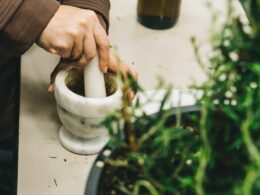So you’ve enjoyed your beautiful geraniums all summer long, but now the season is coming to an end. You may be wondering what to do with them now that the weather is getting colder. Fear not, as there are several options available to ensure the survival of your geraniums for next year’s enjoyment.
First, assess the health and needs of your geraniums. Are they still blooming, or have they started to wither? Are they in pots or in the ground? These are important factors to consider when deciding how to care for them during the winter months.
With a little bit of effort, you can bring your geraniums indoors, store them dormant, or dispose of them properly. Keep reading to learn more about these options and how to keep your geraniums healthy throughout the winter.
Assess Your Geraniums’ Health and Needs
Assessing the health and needs of your geraniums as the season winds down is crucial in determining the best course of action for their care. Check for any signs of disease or pest infestation, such as yellowing leaves, stunted growth, or insect damage. If you notice any problems, take action immediately to prevent further damage to the plant.
In addition to checking for disease or pests, it’s also important to evaluate the soil conditions of your geraniums. If the soil is dry and depleted of nutrients, consider adding fertilizer to help the plant thrive. Pruning techniques can also be used to encourage healthy growth and shape the plant. Remove any dead or damaged leaves and stems to promote new growth.
By assessing the health and needs of your geraniums, you can ensure that they receive the proper care they need to survive the end of the season. Taking action early on can prevent further damage and promote healthy growth for future seasons. Keep in mind the importance of soil conditions and pruning techniques, and don’t be afraid to seek advice from a gardening expert if you’re unsure of what to do.
Bring Geraniums Indoors
Bring those beautiful, vibrant geraniums inside and keep their colorful blooms bright all winter long! It’s crucial to repot your geraniums before bringing them indoors for their growth and survival. Make sure to use fresh soil and a larger pot to allow your geraniums to continue to grow. Also, trim back any dead or unhealthy foliage before repotting to promote new growth.
Choosing the appropriate indoor location for your geraniums is important. Geraniums need plenty of sunlight, so choose a spot that receives at least six hours of direct sunlight each day. If your home doesn’t have a window with enough light, consider using grow lights to supplement. Keep the temperature between 60 and 70 degrees Fahrenheit and avoid placing your geraniums near drafts or heating vents.
Bringing your geraniums indoors can be a great way to enjoy their beauty year-round. With proper repotting techniques and choosing appropriate indoor locations, your geraniums will thrive and provide vibrant blooms all winter long. Don’t forget to continue to care for them with regular watering and fertilizing to ensure their health and longevity.
How Do I Divide Crocosmia at the End of the Season?
Dividing crocosmia plants at the end of the season ensures their continued health and vitality. Start by lifting the plants carefully, then separate the clumps using your hands or a sharp knife. Ensure each division has ample roots and fan-like foliage. Replant the divisions in well-draining soil with proper spacing and enjoy abundant blooms next season.
Store Geraniums Dormant
If you want to enjoy your beautiful geraniums year after year, storing them dormant is a great option that’ll help you preserve their beauty and vitality. Here are three overwintering methods to keep your geraniums healthy and ready for next season:
-
Dig up the geraniums before the first frost: Before the temperature drops too low, dig up the geraniums from the garden and shake off the soil. Cut back the stems to about six inches and remove any dead or yellowing leaves. Place the roots in a paper bag with some dry peat moss or vermiculite and store them in a cool, dark place with a temperature between 40-50°F.
-
Store the geraniums dormant in pots: Instead of digging up the geraniums, you can also store them in pots. Cut back the stems and remove any dead or yellowing leaves. Water the plants well and let them dry for a day or two. Place the pots in a cool, dark place with a temperature between 40-50°F and water them sparingly throughout the winter.
-
Hang the geraniums upside down: Another option is to hang the geraniums upside down in a cool, dark place with a temperature between 40-50°F. Cut back the stems to about six inches and remove any dead or yellowing leaves. Tie a string around the stems and hang them upside down from a hook or hanger.
By using these overwintering methods, you can ensure that your geraniums will survive the winter and be ready for next season. Just remember to check on them periodically and water them sparingly if needed. With the right temperature requirements, your geraniums will be healthy and thriving in no time!
Dispose of Geraniums
When it’s time to dispose of your geraniums, there are several options available to you. You can be environmentally conscious by composting, which is a great way to break down the plant material and create nutrient-rich soil. Another option is recycling, as some areas have programs that accept plant material. If those options aren’t available, you can simply throw the geraniums away with your regular trash.
Composting
By composting your geraniums at the end of the season, you can benefit both your garden and the environment.
Composting is a natural process of breaking down organic matter, like plant material, into nutrient-rich soil.
Instead of throwing away your geraniums, you can use them to create compost that will nourish your garden and reduce waste.
To start composting your geraniums, simply add them to a compost bin or pile along with other organic material like leaves, grass clippings, and food scraps.
Make sure to mix the material regularly and keep it moist to encourage decomposition.
Within a few months, you’ll have a rich, dark soil that can be used to fertilize your plants.
Composting not only benefits your garden, but it also reduces the amount of waste sent to landfills, which helps to preserve the environment for future generations.
Recycling
You can help the environment and keep your home clean by recycling household items like plastic bottles, cardboard, and aluminum cans. But did you know that you can also recycle your geraniums at the end of the season?
Instead of throwing them away, consider upcycling or repurposing them. One way to upcycle your geraniums is by taking cuttings and propagating new plants for the next season. Simply cut a healthy stem, remove the lower leaves, and place it in water. Within a few weeks, new roots will grow, and you can plant it in soil.
Another option is to dry the flowers and use them for potpourri or as a natural air freshener. You can also make a tea with the dried leaves, which is said to have medicinal properties.
By upcycling your geraniums, you not only reduce waste but also save money on buying new plants and household products.
Disposal Options
In this section, we’ll explore the different ways to dispose of your geraniums after they’ve finished blooming. While recycling may seem like a good option, it’s not always possible as some parts of the plant can’t be recycled.
So, what are your other options? One option is to donate your geraniums to a local community garden or plant drive. Many community gardens are often in need of plants, and your geraniums could be a great addition.
Additionally, some organizations may hold plant drives where they collect plants to distribute to schools, hospitals, or other community organizations. Donating your geraniums to one of these drives could not only help your community but also ensure your plants are given a new life.
Tips for Keeping Geraniums Healthy Throughout Winter
Keep your geraniums thriving all winter long with these helpful tips! First, consider overwintering techniques to help your plants survive the colder months.
One option is to bring your geraniums inside and place them near a sunny window. Be sure to water them sparingly and avoid fertilizing during this time.
Another option is to simply cut back the plants and store them in a cool, dark place, such as a basement or garage.
Indoor care is also crucial for keeping your geraniums healthy throughout the winter. Make sure to provide adequate light and keep the temperature around 60-65°F.
It’s important to keep the soil moist but not too wet, as overly damp soil can lead to root rot. You may also want to mist the leaves occasionally to increase humidity.
By following these tips, you can enjoy your geraniums all year long and avoid having to replant every spring. With a little care and attention, your plants will thrive throughout the winter and be ready to bloom again come springtime.
Frequently Asked Questions
Can geraniums survive in extremely cold temperatures?
If you’re wondering whether geraniums can survive in extremely cold temperatures, the answer is yes, they can! But they do need some winter protection, especially if you’re in a particularly harsh climate.
One way to protect your geraniums during the winter is by overwintering them indoors. To do this, you’ll need to bring them inside before the first frost and keep them in a cool, dark place like a basement or a garage. You can also prune them back to a height of about 6 inches and remove any dead or diseased leaves.
Another option is to cover your outdoor geraniums with a layer of mulch or straw to help insulate them from the cold. Just make sure to remove the covering in the spring when the weather starts to warm up again.
With a little bit of care, your geraniums can survive the winter and thrive again next season.
How often should geraniums be watered during the winter months?
During the winter months, it’s important to pay attention to the watering frequency of your geraniums. These plants require soil moisture, but it’s important not to overwater them.
A good rule of thumb is to wait until the top inch of soil is dry before watering again. Overwatering can lead to root rot and other diseases, so be sure to check the soil regularly and adjust your watering schedule accordingly.
By giving your geraniums the right amount of water, you’ll help them stay healthy and strong throughout the winter season.
Should I prune my geraniums before bringing them indoors?
To ensure that your geraniums survive the winter indoors, it’s important to prune them before bringing them inside. Pruning techniques include removing any dead or damaged foliage and cutting back the stems by about one-third. This will encourage new growth and prevent the plant from becoming too leggy.
Overwintering strategies include placing the plants in a sunny window, keeping the soil moist but not wet, and fertilizing them every 2-3 weeks. By following these simple steps, you can keep your geraniums healthy and thriving all winter long.
Can geraniums be propagated during the winter months?
Want to propagate your geraniums during the winter months? Indoor propagation is your answer!
With some basic overwintering techniques, geraniums in containers can thrive and provide new cuttings for your next growing season. Start by taking cuttings from the tip of a healthy stem and removing the lower leaves.
Dip the cut end in rooting hormone and plant in a well-draining soil mix. Keep the soil moist and the cutting in a warm, bright location.
With patience and care, you can enjoy new geranium plants without having to wait for the next outdoor season.
What is the best way to repot geraniums in the spring after being stored dormant?
Once your geraniums have been stored dormant over the winter, it’s important to repot them properly in the spring to ensure their health.
When choosing a potting mix, there are a few options to consider such as a mix specifically designed for geraniums or a general purpose mix with added perlite for better drainage.
It’s also important to choose a pot that is slightly larger than the previous one to allow for growth.
When repotting, gently loosen the roots and remove any dead or damaged ones before placing in the new pot with fresh potting mix.
Overwintering strategies such as keeping them in a cool, dark place and watering sparingly will also aid in their overall health and longevity.
By following these simple steps, you can ensure your geraniums thrive in their new pot and continue to bloom beautifully throughout the season.
Conclusion
Now that you know what to do with your geraniums at the end of the season, you can ensure that they stay healthy and vibrant for years to come.
Whether you choose to bring them indoors, store them dormant, or dispose of them, it’s important to assess their health and needs first.
If you decide to bring your geraniums indoors, remember to provide them with plenty of light and water. If you choose to store them dormant, make sure they’re in a cool, dark place with low humidity. And if you decide to dispose of them, consider composting them to give back to the earth.
By following these simple tips, you can enjoy your geraniums year after year. So don’t let the end of the season get you down – just follow these steps and you’ll have beautiful, healthy geraniums for seasons to come.









